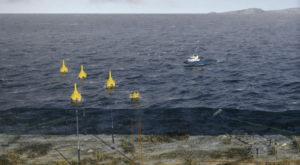DMEC models forecast tidal and wave energy growth in Europe
The Dutch Marine Energy Centre (DMEC) has unveiled a market report forecasting that tidal and wave energy could anchor Europe’s green transition and bring billions in market value by 2050, however, there are certain challenges that need to be surpassed for them to reach their potential.

Leveraging historic data from offshore wind energy development, DMEC’s projections highlight transformative milestones for these renewable energy technologies, with billions in market value and significant cost reductions anticipated by 2050.
“With EU targets of 100 MW in 2025, 1 GW in 2030, and 40 GW in 2050 of ocean energy, a significant portion of those targets is expected to be met by wave and tidal projects,” DMEC said.
Tidal energy growth and market potential
DMEC’s growth curve and doubling time models predict tidal energy in Europe will achieve an installed capacity of 323 to 594 MW by 2030.

According to DMEC, this capacity equates to a market value of €300 to €400 million, with an estimated levelized cost of energy (LCOE) of 95 €/MWh. The growth trajectory aligns with projections from the TIGER project, further validating the industry’s upward momentum.
Related Article
-
TIGER project puts tidal energy in UK and France back on track
Business Developments & Projects
By 2043 to 2045, Europe’s tidal energy capacity is expected to achieve its technical potential of 20 GW, commanding a market value of approximately €1.9 billion, DMEC said.
Cost-competitiveness is also set to improve, with TIGER’s analysis forecasting an LCOE of 75 €/MWh by 2040 and 45 €/MWh by 2050.
Such milestones signal tidal energy’s readiness to play a pivotal role in Europe’s renewable energy mix, providing both environmental and economic benefits, said DMEC.
Wave energy market
For wave energy, DMEC projects a capacity of 89-119 MW by 2030, translating to a market value of €44-64 million annually at a current LCOE of 170 €/MWh.

Though wave energy’s LCOE remains higher in the near term, the long-term outlook is promising.
By 2040, the LCOE is expected to fall to 70 €/MWh and could drop as low as 40 €/MWh by 2050. Achieving these cost reductions could see the wave energy market generate €3 billion annually by mid-century, DMEC reported.
“With the vast amount of available energy in the oceans, an estimated 1.8 TW with 500 GW easily accessible, wave energy alone could meet 10-20% of global electricity demands. Therefore ensuring the rapid development and commercialization of these technologies is pivotal in ensuring a prompt and successful energy transition,” DMEC said.
Modeling based on offshore wind success
DMEC said its forecasting methods are rooted in the growth dynamics of offshore wind energy, a sector that has demonstrated exponential growth over the past three decades.
According to DMEC, the growth curve model uses exponential fitting of cumulative capacity, while the doubling time model analyzes capacity growth over 30-year periods. These methods provide a framework for predicting how marine energy technologies could evolve as they scale up.
While these forecasts are promising, the report highlights challenges that need to be addressed for tidal and wave energy to reach their potential.
According to DMEC, key hurdles include securing investment, advancing technology, and achieving necessary cost reductions. However, with increasing support from governments and industry stakeholders, these challenges are seen as attainable.
With a combined market value potential of nearly €5 billion annually, these technologies represent a cornerstone of the continent’s green energy transition.
A recent study led by European universities showed that wave energy could rival the cost-effectiveness of offshore wind by the 2030s at favorable locations.
In terms of other recent news, a DMEC-led Offshore Accelerator for System Integration and Storage (OASIS) project launched in September, aiming to accelerate system integration and storage solutions for offshore renewable energy (ORE).
Targeting small and medium-sized enterprises (SMEs), the program will offer tools, training, market research, and a strong network to support the sector.
Related Article
-
Offshore renewable energy SMEs to benefit as new DMEC-led project launches, targeting sector support
Business Developments & Projects








